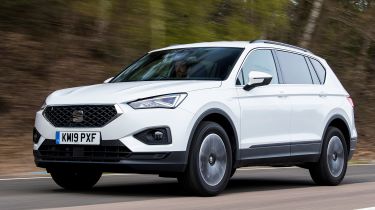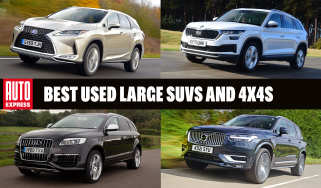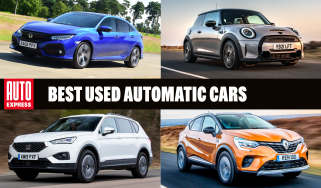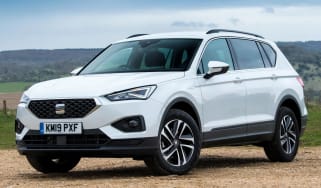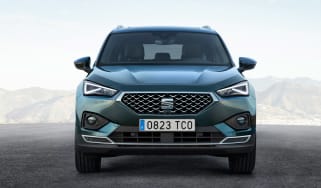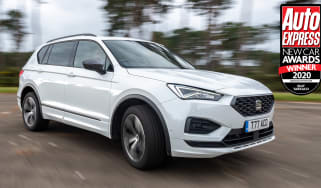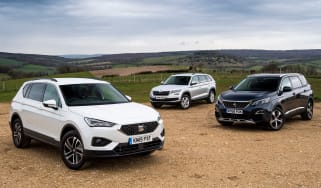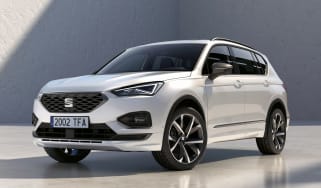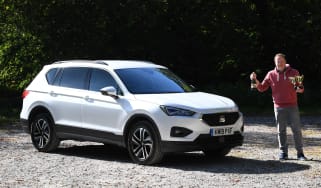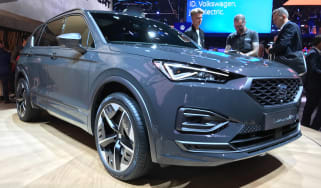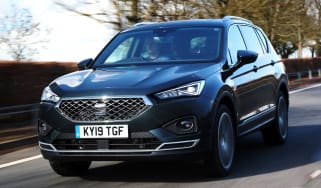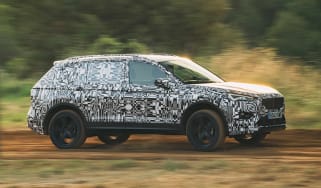SEAT Tarraco (2019-2024) review
If you fancy a family seven-seater SUV with a sportier edge, then the SEAT Tarraco may be worth considering

This is a review of a new 2019-2024 Tarraco. If you are interested in information about a used SEAT Tarraco, please follow the links provided.
The stylish looking SEAT Tarraco seven-seater SUV offers plenty of space for the family and will even keep the driver entertained with a surprisingly sporty drive. Closely related to the Skoda Kodiaq, the Tarraco is as classy and robust as you'd expect a model to be from the VW Group stable.
There’s no electrified model available, but the petrol and diesel engines offer good economy as well as decent pace, while the Tarraco's keen pricing means that it deserves some consideration.
About the SEAT Tarraco
The Tarraco is SEAT's first SUV that offers seven seat flexibility. With a large boot and a generous level of equipment, it can comfortably meet the demands of a growing family, although the third row of seats – which are standard across the range – are best reserved for occasional use.
The Tarraco is closely related to the Skoda Kodiaq, but the SEAT edges the Skoda in terms of styling and driver appeal, although it can’t match its Czech mate when it comes to practicality and flexibility. There is no shortage of other rivals, with the Hyundai Santa Fe, Kia Sorento and Peugeot 5008 also offering seven seats.
Used - available now

2022 BMW
3 Series
27,305 milesAutomaticPetrol2.0L
Cash £22,300
2020 BMW
3 Series
61,740 milesAutomaticDiesel2.0L
Cash £19,300
2025 Kia
Niro EV
28,985 milesAutomaticElectric
Cash £19,900
2020 Ford
Focus
69,320 milesManualDiesel1.5L
Cash £9,400In a very short space of time, SEAT progressed from a company with no SUVs to having three models in its lineup. The Tarraco sits at the top of this SUV family, above the mid-sized Ateca and small Arona. It shares the same platform as the Skoda Kodiaq, but while the Skoda is focused on flexibility and practicality, the Tarraco has a sportier feel, as it sits 20mm lower.
That doesn’t make the Tarraco a sporty car, but as seven-seat SUVs go, it offers a fair amount of driver appeal. It feels good in corners and rides well over all surfaces, with only a limited level of body roll when cornering.
Thanks to LED lighting at the front and rear, a bold face and chunky SUV styling, the Tarraco is one of the best looking seven-seat SUVs on the market, especially in FR Sport or XPERIENCE trims, which ride on 19- or 20-inch alloy wheels.
Be warned, the larger alloy wheels might look the part, but the Tarraco rides better on smaller wheels. There is a choice of petrol and diesel power, with four-wheel drive available if you need it.
SEAT has gradually expanded the Tarraco line-up since its launch in 2019, but the trim selection is still simple to follow. SE and SE Technology make up the more affordable trims. Above this, you have the choice of the sportier FR and FR Sport or the more luxurious XPERIENCE and XPERIENCE Lux models.
Standard specification is high, with even entry-level SE cars offering metallic paint, LED headlights and rear lights, an eight-inch touchscreen, Apple CarPlay, Android Auto, easy-fold rear seat system, rear parking sensors, auto lights and wipers and three Isofix points in the middle row.
Opting for the sports-oriented FR trim gives the Tarraco tweaked exterior detailing, which includes a spoiler, black door mirrors and roof rails. Inside, sports seats are added along with keyless entry. FR Sport adds larger 20-inch alloy wheels, a top-view camera and SEAT’s digital cockpit.
If you prefer luxury over sportiness, the XPERIENCE trim includes Alcantara seats, park assist and adaptive cruise control, along with chrome exterior detailing. The XPERIENCE Lux upgrades the upholstery to leather, and adds in a heated driver’s seat with electric and memory functions.
How much does the Seat Tarraco cost?
Prices start from around £33,500 for the 148bhp 1.5-litre petrol SE model, rising to over £42,000 for the 242bhp FR Sport with a 2.0-litre TDI diesel engine and DSG automatic transmission. This higher price edges the Tarraco into a higher rate of VED for the first five years you own it, which is something to consider when buying new.
Engines, performance and drive
For a seven-seat SUV, the SEAT Tarraco is remarkably good to drive, offering more driver appeal than the Skoda Kodiaq, even though it shares the same platform. It helps that the Tarraco sits 20mm lower to the ground, which means body roll is kept in check.
This means that you can change direction with confidence, with the responsive steering encouraging you to press on when cornering. Sure, it’s far from sporty, and we suspect the majority of customers won’t be placing dynamics too close to the top of the list of priorities.
You can select from four different driving modes – Normal, Sport, Eco or Individual – although we question the relevance of a Sport mode on a seven-seat SUV. We think it’s better to enjoy the Tarraco’s long suspension travel and revel in the soft and cushioning ride, especially if you’ve opted for an SE model with 17- and 18-inch alloy wheels.
Engines, 0-60 acceleration and top speed
The Tarraco was originally available with two petrol engines, a 1.5- and 2.0-litre TSI unit producing 187bhp and 242bhp respectively. The larger engine was discontinued in 2022, so the sole petrol option is now the 1.5-litre. This engine can feel a little underpowered, especially when fully-laden. There’s only 250Nm of torque on offer, and all of the power is produced at the higher end of the rev range.
Both the petrol and diesel versions of the Tarraco come with the option of a six-speed manual or seven-speed DSG automatic gearbox. The automatic petrol-powered Tarraco will cover 0-62mph in a leisurely 9.7 seconds before hitting a top speed of 124mph. Manual versions see an increased 0-62mph time of 9.9 seconds but the same top speed.
Just like the petrol, there were also two diesel engines offered when the Tarraco originally launched in 2019. These were both 2.0-litre TDI units that were available with either 148bhp or 197bhp, but the more powerful version has since been axed. The less powerful engine still produces 340Nm of torque, though, so it does have enough pulling power for a fully-laden SUV.
The diesel-powered Tarraco will deal with the 0-62mph sprint in a reasonable 9.9 seconds if you opt for the seven-speed DSG automatic, and this will proceed to a top speed of 122mph. These figures change to 10.2 seconds and 123mph for the six-speed manual.
MPG, CO2 and running costs
Predictably, the 2.0 TDI diesel with manual gearbox is the most fuel efficient Tarraco, offering a claimed average of 52.3mpg on the WLTP combined cycle. In common with all the engines, avoiding the larger alloy wheels will help to optimise fuel economy. Adding a DSG gearbox to the diesel brings a fuel penalty, with this version dropping down slightly to an average 51.4mpg.
The 1.5-litre petrol sees a reasonable 42.4mpg when mated to the manual ‘box - dropping to 40.4mpg for the automatic. Choosing the diesel engine and entry-level SE trim will give you the least-polluting Tarraco, generating 142g/km of CO2. The petrol-powered XPERIENCE is the least eco-friendly, emitting 165g/km.
Insurance groups
The Tarraco ranges between insurance groups 18-20. The cheapest version to insure is the 1.5-petrol in SE trim fitted with the manual gearbox. In comparison, the closely related Skoda Kodiaq resides in groups 21-28.
Depreciation
Our experts predict that the Tarraco will retain between 44 and 47 per cent of its initial value over a typical ownership period of three years or 36,000 miles. The best performer is the diesel-powered Tarraco in SE trim with a DSG automatic gearbox.
To get an accurate valuation on a specific model check out our free car valuation tool...
Interior, design and technology
The Tarraco follows the Arona and Ateca as SEAT’s third SUV, and it’s arguably the best looking of the trio. For such a large car, it hides its size well, with a front end dominated by a prominent grille and stylish LED headlights.
In truth, the Tarraco looks at its best in the XPERIENCE Lux trim, with 20-inch alloy wheels, chrome accents, eye-catching grille and body-coloured bumpers combining to create a look that can hold its own against more premium SUVs in the segment. The larger wheels might not do much for the ride quality, but they score highly in terms of street appeal.
On the inside, the Tarraco feels every inch a product of the Volkswagen Group, although it’s subtly different to the Arona and Ateca. The key to this is the eight-inch ‘floating’ touchscreen, although it does look like a bit of an afterthought.
There’s a generous level of standard kit, as even the entry-level SE features 17-inch alloy wheels, ambient lighting, three-zone climate control, auto headlights and wipers, four driving modes, cruise control and rear parking sensors. SE Technology adds 18-inch wheels, dark tinted windows, ambient lighting in the front and rear door panels and sat-nav with a 3D map display.
The FR offers a more dynamic look with 19-inch alloys and exterior black trim, while the FR Sport continues the stylish appearance with 20-inch wheels and a rear view camera. The XPERIENCE features 19-inch alloy wheels, chrome exterior trim, illuminated door sills, Alcantara sports seats, park assist, a wireless phone charger, keyless entry and go, adaptive cruise control and a rear-view camera. These are in addition to the cosmetic upgrades mentioned earlier.
In XPERIENCE Lux guise, the Tarraco pushes into premium territory, both in terms of price and spec, boasting 20-inch wheels, leather sports seats, heated front and outer rear seats, a top view camera and an electric driver’s seat.
Sat-nav, stereo and infotainment
We like the eight-inch touchscreen, which is responsive, bright and features the appropriate smartphone connectivity. But in this age of integrated tech, it looks as if it has been bolted on at the last minute.
On the plus side, Apple CarPlay and Android Auto are standard across the range, while all cars bar the entry-level SE feature sat-nav. Rather brilliantly, a digital cockpit, which is similar in style to Audi’s Virtual Cockpit, is standard on all models.
Practicality, comfort and boot space
If you regularly carry seven onboard, then you may find the Tarraco a bit of a squeeze. It's far more suited for use as a five-seater, with the third row of seats designed for occasional use by children.
There are plenty of useful storage options, however, including door bins wide enough to house a large bottle of water, a storage bin beneath the centre armrest and two large cup holders.
Dimensions and size
The Tarraco is 4,735mm long, 1,839mm wide and 1,674mm tall (including the roof bars), making it similar in size to the closely related Skoda Kodiaq.
Leg room, head room & passenger space
When judged as a five-seat SUV, the SEAT Tarraco is easy to recommend. There’s plenty of room in the first and second rows of seats, with enough adjustment in the driver’s seat to create a comfortable driving position.
The driver and front seat passenger will find a generous amount of shoulder room, while there’s enough space in the second for three adults. The amount of headroom is excellent throughout the cabin, while three sets of Isofix mounts across the rear seats will be useful for families.
It’s only when you climb into the third row of seats that things start to get a little cramped. Young children and early teens will have little cause for complaint, but adults will find it rather uncomfortable. It’s also worth noting that there are no Isofix mountings in the third row.
The second row of seats split 40/20/40, which means you can fold the middle seat down when carrying long items, but still make use of the outermost seats.
Boot space
While the Tarraco and Kodiaq are incredibly similar, it’s the Skoda that boasts the larger boot. In the SEAT, you get 700 litres with the third row of seats folded down, but the Skoda offers an additional 20 litres of luggage capacity.
It’s a similar story when you fold down the second row of seats, with the Tarraco liberating 2,005 litres of space and the Kodiaq offering a cavernous 2,065 litres. It’s not that the Tarraco is small; it’s just that Skoda does flexibility and practicality better than most brands.
You’ll also find the likes of umbrellas in the doors, an ice scraper behind the fuel filler cap and door protectors in the Skoda, but not in the SEAT. Small details, perhaps, but they soon add up when you start looking at an SUV as a long-term proposition.
The Tarraco’s third row of seats fold down to create a totally flat floor, although the space is flanked by two deep wells, which is far from ideal.
Towing
All versions of the Tarraco have a maximum unbraked towing capacity of 750kg, but the diesels are the star cars if you intend to tow a caravan or a boat. When mated to the seven-speed DSG automatic gearbox, the 2.0-litre diesel has a maximum braked capacity of 2,200kg.
Reliability and safety
The Tarraco was tested by Euro NCAP in early 2019, and it earned a five-star safety rating, as well as a 97 per cent adult occupant protection score. The mechanically similar Skoda Kodiaq also received full marks in 2017.
Adaptive cruise control, a lane-keeping assist function, a front assist system with bicycle detection, and an emergency call system are standard across the range. Also available are blind spot detection, traffic sign recognition, emergency assist, plus, for the first time on a SEAT, pre-crash assist and rollover assist.
Pre-crash assist can react in two tenths of a second if it detects an accident is about to occur – tightening the seatbelts, activating the hazard lights, rolling up the windows and closing the sunroof. If activated, rollover assist will make an emergency call, turn off the engine, turn on the hazard lights and change the ventilation system.
The Tarraco didn't feature in our 2023 Driver Power customer satisfaction survey, but the smaller Arona and Ateca SUVs finished in 59th and 53rd position, respectively, on the 75-car list. SEAT finished in a middling 23rd spot out of 32 brands in the best car manufacturer rankings. It’s worth noting, though, that this was a higher rank than Audi and Volkswagen.
Warranty
The Tarraco is covered by a pretty standard three-year/60,000-mile warranty, but this can be extended at the time of ordering. A four-year/75,000-mile or five-year/90,000-mile extended warranty package are both available at an extra cost, and these are fully transferable to the next owner.
Servicing
If you cover fewer than 10,000 miles in a year and make a lot of short journeys, you’re advised to service the Tarraco on an annual basis. However, if you drive mainly on motorways, it’s recommended that you visit a service centre at intervals of no more than 20,000 miles. A fixed price service plan is available and covers the first and second-year services.

